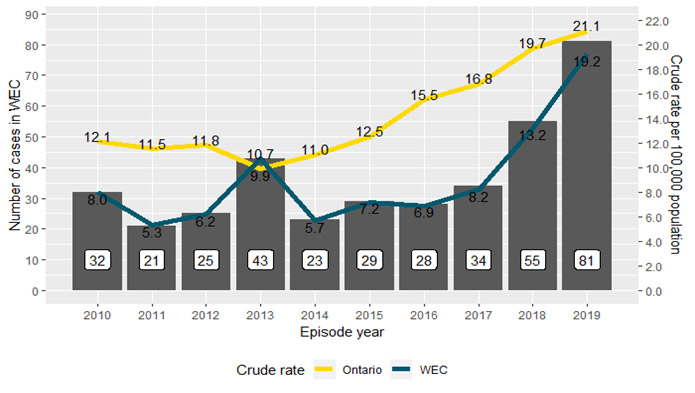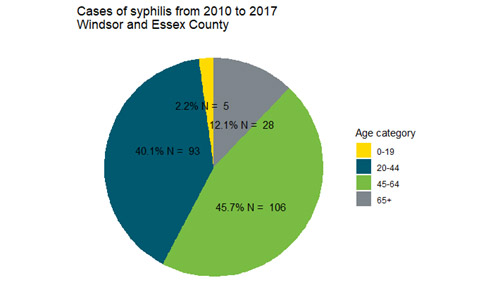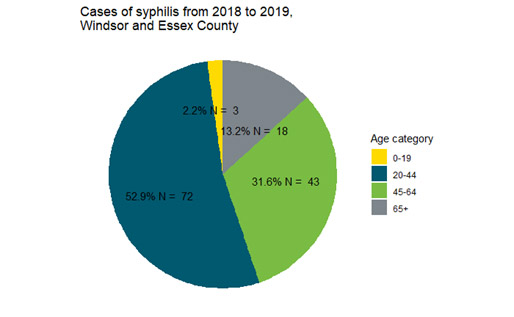What is Syphilis?
Syphilis is a bacterial infection caused by Treponema pallidum bacteria and spread by sexual contact (Heymann, 2015). The disease can result in either acute or chronic outcomes resulting in four possible stages of infection, if left untreated (Government of Canada, 2020):
- Primary syphilis is characterized by the appearance of painless ulcer(s) or chancre and swollen lymph nodes (Heymann, 2015; Public Health Ontario, 2014).
- Secondary syphilis develops after the resolution of the ulcer(s) or chancre and is followed with a rash on the palms and soles alongside swollen lymph nodes (Heymann, 2015; Public Health Ontario, 2014).
- Latent syphilis occurs once the symptoms of the secondary stage has resolved and can be further classified as (Heymann, 2015; Public Health Ontario, 2014):
- Early latent infection – within the first year of the infection
- Late latent infection – after the first year of infection
- Tertiary syphilis is a late stage if latent syphilis is untreated (Heymann, 2015; Public Health Ontario, 2014). This stage occurs after many years and can affect the cardiovascular, skeletal and neurological systems (i.e., neurosyphilis; (Heymann, 2015; Public Health Ontario, 2014).
Individuals can spread the disease from the primary to latent stage and, at times, if they have neurosyphilis. As mentioned, syphilis spreads through sexual contact and can be passed from an infected mother to her baby before (e.g., across the placenta) or during birth (Heymann, 2015; Public Health Ontario, 2014). While symptoms can appear from ten days to three months, typically they occur at approximately three weeks (Public Health Ontario, 2014).
Local and Provincial Trends
- The incidence of syphilis in WEC and Ontario have risen in recent years. From 2010 to 2019, the crude rate of syphilis (number of cases per 100,000 residents) in Ontario has increased from 12.1 to 21.1.
- While the rate in WEC is lower than Ontario for almost every year, an increase in the rate is apparent. From 2010 to 2019, the crude rate has increased from 8.0 to 19.2. This increase in WEC is largely apparent in the years since 2017 (Figure 1). In 2019, there were 81 laboratory confirmed cases of syphilis in WEC.
Figure 1: Incidence of syphilis in Windsor and Essex County and Ontario, 2010 to 2019

Source: Public Health Ontario. Infectious Disease (ID) Query Tool [2010-2019].
Age and Gender Distribution
- The majority of syphilis cases are males. Of the cases in WEC between 2010 and 2019, 81% of cases are males (Table 1).
- The vast majority of syphilis cases are between 20-64 years of age (Figure 2 and Figure 3).
- When the age-distribution of cases between 2010 and 2018 were compared to cases in 2019, there was some difference. In 2010 to 2017, only 40.1% of cases were 20-44 years of age. However, in 2019, this proportion has increased to 52.9% of cases.
|
Gender |
Cases |
Percentage |
|---|---|---|
|
Male |
297 |
81 |
|
Female |
70 |
19 |
Source: Ontario Ministry of Health and Long-Term Care. integrated Public Health Information System (iPHIS) [2010-2019].
Figure 2: Age distribution of syphilis cases in Windsor and Essex County, 2010 to 2017

Source: Ontario Ministry of Health and Long-Term Care. integrated Public Health Information System (iPHIS) [2010-2019].
Figure 3: Age distribution of syphilis cases in Windsor and Essex County, 2018 to 2019

Source: Ontario Ministry of Health and Long-Term Care. integrated Public Health Information System (iPHIS) [2010-2019].
Risk Factors
- Not using a condom was the most commonly reported risk factor among cases that reported at least one risk factor.
- Between 2010 to 2017 and 2018 to 2019 there were some changes with respect to risk factor trends. In 2010-2017, sex with opposite sex was reported by 42% of cases that reported a risk factor and similarly, and sex with same sex was reported by 34% of cases. However, in 2018 to 2019, sex with same sex was the second most reported risk factor (66%) and sex with opposite sex was only reported by 29% of cases that reported a risk factor.
- Moreover, the proportion of cases that reported more than one sex partner in the past six months has increased (2010-2017: 15% of cases, 2018-2019: 45% of cases). Similarly, the proportion of cases that reported a new sex partner in the past two months has also increased (2010-2017: <10% of cases, 2018-2019: 37% of cases). The top risk factors reported by cases are shown in Table 2 and Table 3.
|
Year |
Disease |
Risk Factor |
Numerator |
Denominator |
(%) |
|---|---|---|---|---|---|
|
2010-2017 |
Syphilis |
No condom used |
59 |
80 |
74 |
|
2010-2017 |
Syphilis |
Sex with opposite sex |
34 |
80 |
42 |
|
2010-2017 |
Syphilis |
Sex with same sex |
27 |
80 |
34 |
|
2010-2017 |
Syphilis |
More than one sex contact in last 6 months |
12 |
80 |
15 |
|
2010-2017 |
Syphilis |
Anonymous sex |
9 |
80 |
11 |
|
2010-2017 |
Syphilis |
HIV status |
8 |
80 |
10 |
|
2010-2017 |
Syphilis |
Tattoo and piercing |
8 |
80 |
10 |
Source: Ontario Ministry of Health and Long-Term Care. integrated Public Health Information System (iPHIS) [2010-2019].
Note: Only risk factors with a percentage greater than or equal to 10% are shown.
|
Year |
Disease |
Risk Factor |
Numerator |
Denominator |
% |
|---|---|---|---|---|---|
|
2018-2019 |
Syphilis |
No condom used |
97 |
123 |
79 |
|
2018-2019 |
Syphilis |
Sex with same sex |
81 |
123 |
66 |
|
2018-2019 |
Syphilis |
More than one sex contact in last 6 months |
55 |
123 |
45 |
|
2018-2019 |
Syphilis |
New contact in past 2 months |
45 |
123 |
37 |
|
2018-2019 |
Syphilis |
Sex with opposite sex |
36 |
123 |
29 |
|
2018-2019 |
Syphilis |
Anonymous sex |
15 |
123 |
12 |
|
2018-2019 |
Syphilis |
Other |
14 |
123 |
11 |
|
2018-2019 |
Syphilis |
HIV status |
12 |
123 |
10 |
Source: Ontario Ministry of Health and Long-Term Care. integrated Public Health Information System (iPHIS) [2010-2019].
Note: Only risk factors with a percentage greater than or equal to 10% are shown.
References
- Government of Canada. Syphilis [Internet]. Ottawa, ON: Her Majesty the Queen in Right of Canada; 2020 [updated January 22, 2020; cited January 22, 2020]. Available from: https://www.canada.ca/en/public-health/services/diseases/syphilis.html
- Heymann DL, editor. Control of Communicable Diseases Manual. 20 ed. Washington, D.C: American Public Health Association: 2015
- Ontario Agency for Health Protection and Promotion (Public Health Ontario). Reportable disease trends in Ontario, 2011. Toronto, ON: Queen’s Printer for Ontario; 2014.

